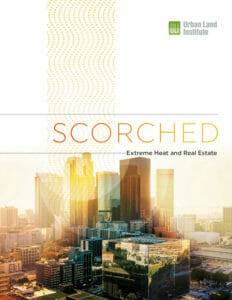Staff of Urban Land Institute writes:
The impact that rising temperatures and excessive heat waves are having on urban development, and strategies to mitigate urban heat island effects are explored in a new report, Scorched: Extreme Heat and Real Estate, published by the Urban Land Institute (ULI). ULI is a global real estate organization with more than 44,000 members dedicated to responsible land use and the creation of sustainable, thriving communities.
 Scorched: Extreme Heat and Real Estate, published with support from The JPB Foundation, explores how extreme heat is emerging as a growing risk factor and planning consideration across the United States, and how the real estate industry is responding with design approaches, technologies and new policies to mitigate the impacts and help protect human health.
Scorched: Extreme Heat and Real Estate, published with support from The JPB Foundation, explores how extreme heat is emerging as a growing risk factor and planning consideration across the United States, and how the real estate industry is responding with design approaches, technologies and new policies to mitigate the impacts and help protect human health.
The real estate sector can improve resilience to extreme heat through mitigation strategies that reduce temperatures, as well as adaptation tactics to help people and businesses cope with extreme heat, it says.
The report provides an overview of extreme heat’s connections to the built environment and an in-depth discussion of heat mitigation and adaptation strategies related to building design, building materials, green infrastructure and public space design. These strategies can “future-proof” real estate in vulnerable markets; lower operations and management costs; improve tenant and occupant experience; and otherwise differentiate a real estate project.
Scorched provides a snapshot of the issue with several statistics documenting the impact of extreme heat as well as the significant potential of strategies to address it in the built environment:
- $1 billion: The amount saved on electricity costs if all commercial buildings in the U.S. switched from dark to light roofs (source: Global Cool Cities Alliance)
- 30 to 40 degrees Fahrenheit: The amount by which green roofs can be cooler than conventional rooftops (U.S. Environmental Protection Agency)
- 2 years: The average payback time for installing a green roof on commercial buildings (General Services Administration)
- 35 degrees Fahrenheit: The maximum amount that trees reduce surface temperatures — trees also reduce summer air temperatures from 2 degrees to 9 degrees Fahrenheit (Scientific American)
- 10%: The decrease in office worker productivity in thermally uncomfortable and poorly ventilated environments (UK Green Building Council)
By replacing dark, impervious roof surfaces with soil and vegetation, a green roof will lower ambient temperatures, reduce interior temperature fluctuation, improve air quality, reduce building energy use, retain stormwater, and create attractive and useful outdoor amenities. Critically, by reducing extreme temperature fluctuations, green roofs also extend the life of a roof from the traditional about 20 years to about 40 years.
Green walls are an attractive amenity, reduce building energy use, and decrease building envelope surface temperatures as well as surrounding microclimate temperatures. Similar to other vegetative strategies, “the cooling effect of green walls is highly dependent on their orientation, plant density and water content.” Through policies and incentives, cities can create opportunities for developers to implement heat-conscious design elements like green walls.
 Greenroofs.comConnecting the Planet + Living Architecture
Greenroofs.comConnecting the Planet + Living Architecture










Tony Hsu
Taiwan House Power Trees